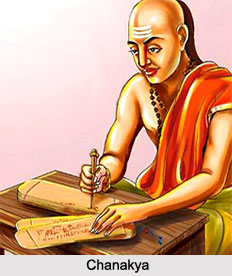 Kautilya was the prime minister of the first Maurya king Chandragupta Maurya. He was born in a Brahmin family at Pataliputra. He was known for his pioneering job in the field of economics, politics as well as statecraft and international relations. Kautilya (350 to 275 BC) had been significantly known for his services in building the empire of Maurya Empire. With his two most popular treatises of Arthashastra and Neetishastra, Kautilya laid the foundation of a strong Hindu empire which has remained unchallenged in the history of ancient India. Chanakya is also known for his second treatise known as Neetishastra or Chanakya Niti. While Arthashastra discusses the monetary and fiscal policies, social; welfare, international relations and war strategies; Neetishastra on the other hand is a treatise on the ideal way of life.
Kautilya was the prime minister of the first Maurya king Chandragupta Maurya. He was born in a Brahmin family at Pataliputra. He was known for his pioneering job in the field of economics, politics as well as statecraft and international relations. Kautilya (350 to 275 BC) had been significantly known for his services in building the empire of Maurya Empire. With his two most popular treatises of Arthashastra and Neetishastra, Kautilya laid the foundation of a strong Hindu empire which has remained unchallenged in the history of ancient India. Chanakya is also known for his second treatise known as Neetishastra or Chanakya Niti. While Arthashastra discusses the monetary and fiscal policies, social; welfare, international relations and war strategies; Neetishastra on the other hand is a treatise on the ideal way of life.
Early Life of Kautilya
Initially he was named Vishnugupta Sharma. Kautilya was born in a Brahmin family as the son of Acharya Chanak in Pataliputra who named him as Chanakya. As a teacher at Taxila, Chanakya began his political expedition at the court of Nanda Kings. After being thrown out of Nanda court, Chanakya was in search of the most able leader. This brought him close to Chandragupta Maurya who possessed all the qualities which Kautilya was searching. The initial challenge for Chanakya was to overthrow the Nanda kings who caused him humiliation and dishonour which could be met only with an equally strong, powerful, mighty, virtuous king who shall overcome all his personal weaknesses and face all situations with grace. He began to build a strong empire against the Nandas.
Contributions of Kautilya
Kautilya in order to groom his king and administer the Mauryan kingdom, introduces a number of strategic methods which include his policies of diplomacy namely the policy of Sama, Dana, Danda and Bheda which means treating with Equity, Enticement, Punishment , War and Sowing the Seeds of Dissension. Kautilya also analysed the merits and demerits of the then prevalent forms of government, namely, monarchy, aristocracy, democracy, republics and a sort of federation. He also taught the king as well as his soldiers to be prepared for all kinds of situations and adverse conditions. While the king is advised to be acquainted with the use of poison, his soldiers as well are trained to go without food and other facilities of life for some period of time. With the help of Arthashastra, Kautilya highlights all the minute details of administration and war strategies which can cause defeat to even a strong empire. Thus he advises the king to be as alert and well equipped for worse conditions.
Death of Kautilya
Kautilya according to the Jain text died at a ripe age during 275 BC. According to Jain traditions, Kautilya`s death was due to the misunderstanding which grew between him and Bindusara, son of Chandragupta Maurya regarding his birth and the death of his mother. As an adviser to the king Kautilya used to apply mild dose of poison to the king to make him get used to poison which was once shared by the king with the queen when she was pregnant for nine months. This forced Kautilya to cut the belly of the queen and save the child from the effect of poison which had just touched the head of the new born. Due to this reason Kautilya named him Bindusara who succeeded the Chandragupta Maurya. As the queen was not used to poison she died after the delivery leaving a stress of suspicion in the mind of Bindusara who blamed Kautilya to have killed the queen. This disappointed the loyal server who decided to renounce food and drinks till he dies. Though Bindusara regretted after knowing the reality but it was too late for an aged Brahmin who died within few days.



















